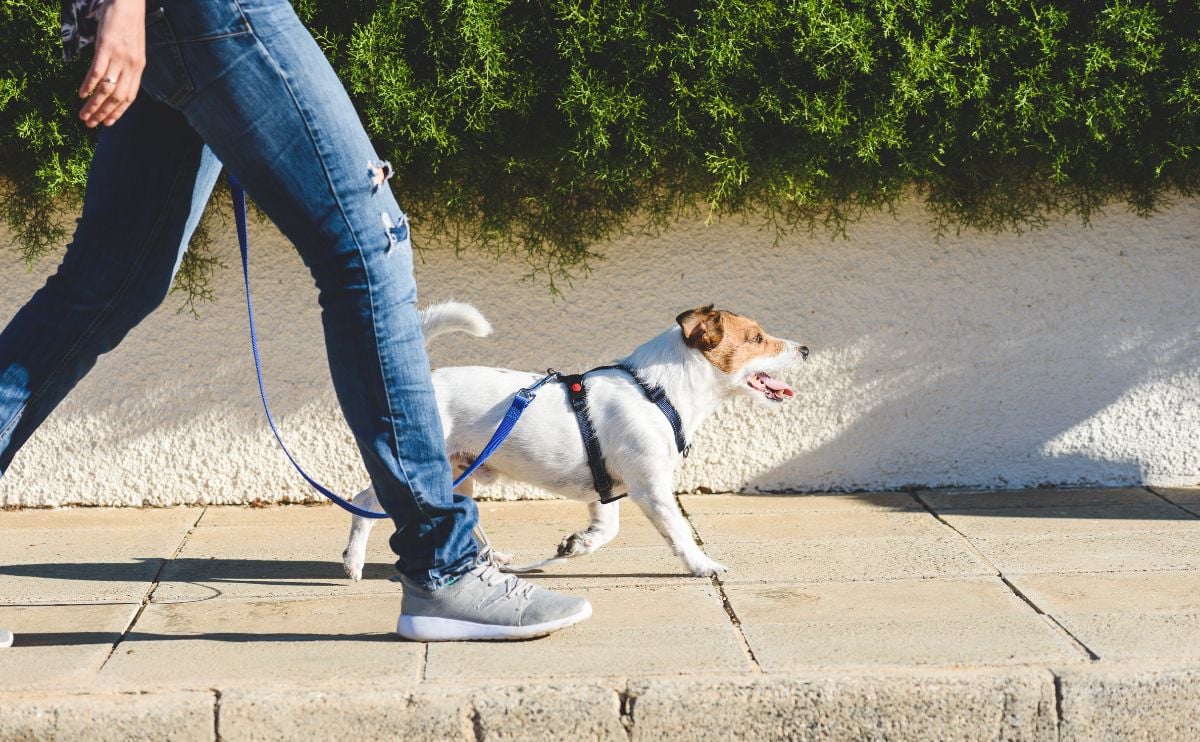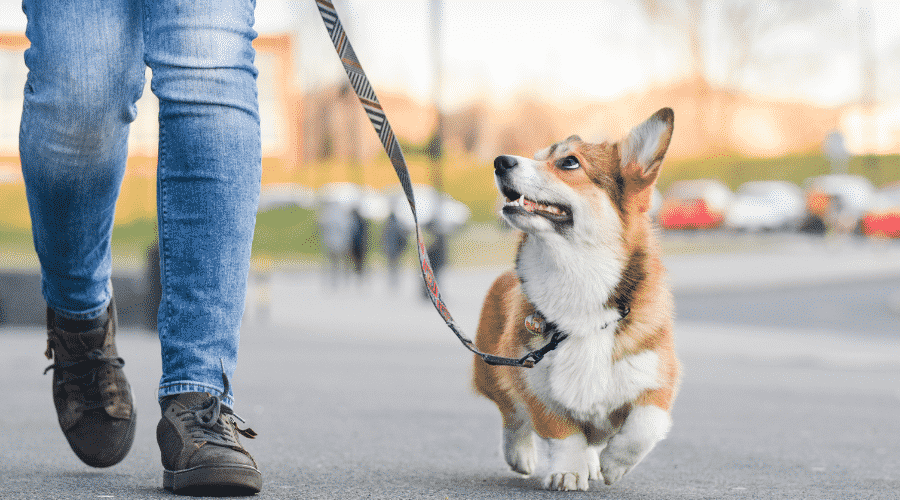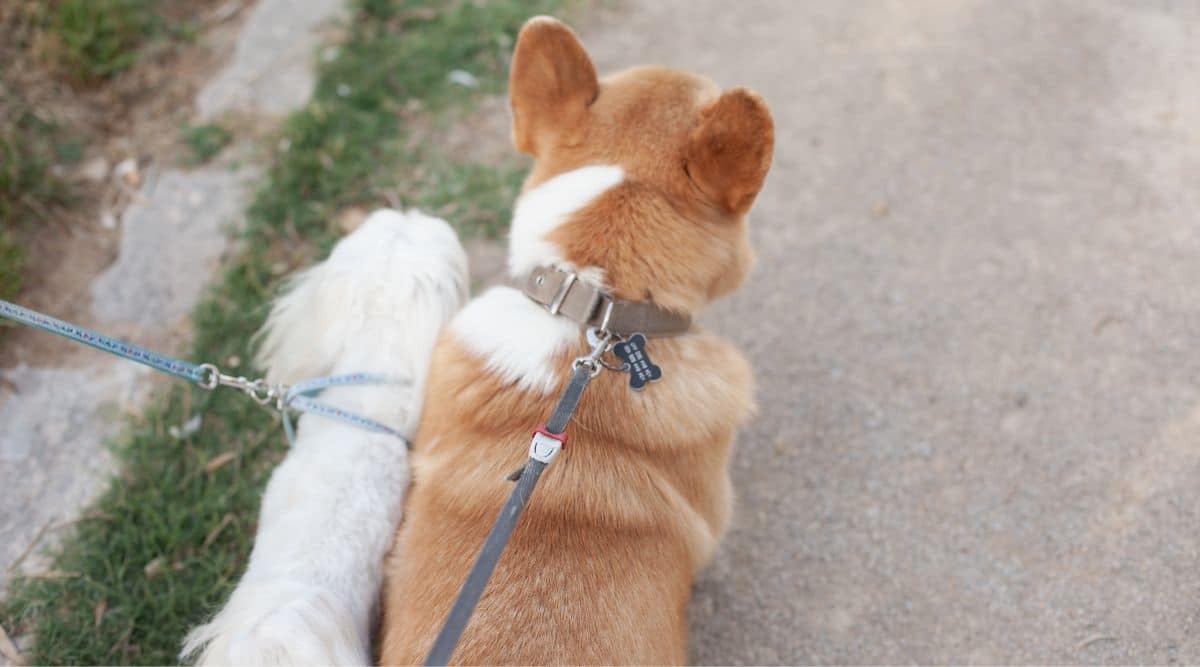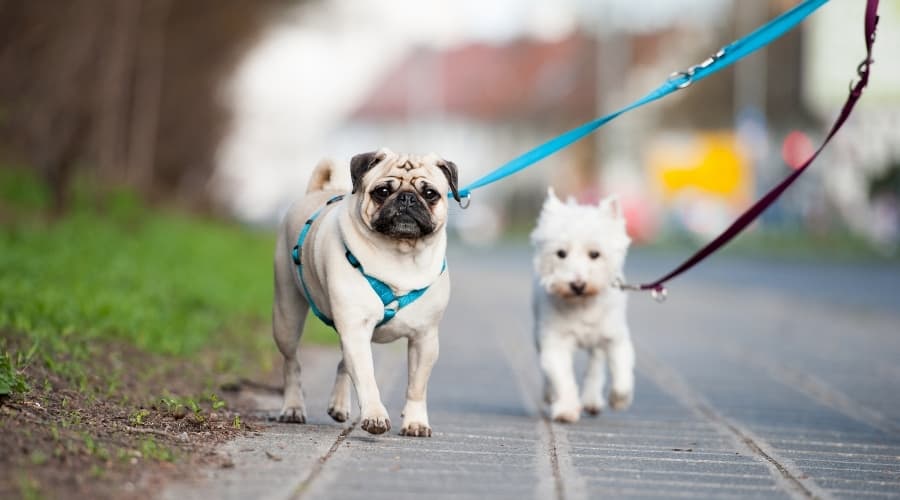How Often Should You Walk Your Dog? The Answer Might Surprise You!
When you purchase through links on our site, we may earn a commission. Here’s how it works.
Think you’re walking your dog enough? You might be making a mistake that could shorten their lifespan. Walking your dog isn’t just about potty breaks. It’s one of the most vital routines for their physical health, mental stimulation, and emotional balance.
Table of Contents
But how often should you walk them? And for how long? The answer isn’t one-size-fits-all. Most pet parents underestimate how much their furry friend actually needs. Factors like age, breed, energy levels, and even the weather all play a role in determining what’s best for your pup.
In this guide, you’ll learn how to tailor the perfect walking routine for your dog, backed by expert advice and real-world tips. This means you can boost their well-being and deepen your bond whenever you grab the leash.

Why Daily Dog Walks Matter More Than You Think
Let’s be honest, we’ve all skipped a dog walk here and there. Maybe it was raining, maybe you were tired, or maybe your pup looked just as cozy as you felt on the couch. But those daily walks? They’re not just a nice-to-have. They’re essential.
Walking your dog regularly does way more than just help them “do their business.” It boosts their physical health, keeps their mind sharp, and helps them stay emotionally balanced, just like exercise does for us humans. And the science backs it up.
- Keeps Them Fit & Healthy. Dogs who get daily exercise are less likely to become overweight or develop joint issues like arthritis. Various studies show that consistent physical activity significantly lowers a dog’s risk of chronic conditions.
- Maintains Digestive Health. Walkies are crucial for digestive health not only for regular pee and poop breaks but to keep the digestive system working properly.
- Stimulates Their Brain. Every sniff, every squirrel chase, every stop-and-stare moment on a walk lights up your dog’s brain like a Christmas tree. Walks aren’t just physical, they’re a full-on mental workout. Dogs are natural sniffers, trackers, and explorers, and walks satisfy their basic needs.
- Reduces Bad Behavior. Got a pup who chews everything in sight or barks at shadows? Maybe they always get up to no good when home alone? Regular walks can work wonders. A tired dog is a happy dog, and a much better-behaved one. A study in Frontiers in Veterinary Science found that consistent physical activity significantly lowers a dog’s risk of bad or anxious behavior.
- Builds Confidence & Social Skills. Walks expose your dog to new sights, sounds, people, and other dogs. Socialization is crucial for puppies and nervous adult dogs alike. The more they explore, the more confident they become.
- Strengthens Your Bond. Research shows there’s nothing like an early morning walk or a golden-hour stroll to bring you and your dog closer. It’s your time together, unplugged, present, and totally pawsome.
Did you know? Research has shown that around 41% of dog owners admit to not walking their dogs regularly. So, if you skip walkies, you’re definitely not alone.
But that doesn’t mean you should. So, if you’ve ever wondered, “Does it really matter if we miss today’s walk?”, the answer is a big, tail-wagging YES.

How Often Should You Walk Your Dog? Expert Guidelines Explained
Ever wonder if you’re walking your dog too much or not enough? You’re not alone. This is one of the most Googled dog owner questions out there. The truth is, there’s no one-size-fits-all answer, but there are solid guidelines based on your dog’s breed, age, and energy level.
The ASPCA recommends a minimum of five 30-minute walks per week (minimum) for most dogs. However, most healthy adult dogs would enjoy at least 30 minutes to 2 hours of activity daily, and walks are the easiest way to get there. That might mean one long walk or a couple of shorter ones spaced throughout the day.
Bottom Line? Walks aren’t optional. They’re non-negotiable for your dog’s health and happiness. However, the right schedule depends on their unique needs.
But what if your dog isn’t like most dogs? Up next, I look at the 5 most significant factors that affect how much walking your dog really needs.
The 5 Key Factors That Determine Your Dog’s Walking Needs
Let’s be real, not all dogs are created equal when it comes to walk time. Some are ready to run a marathon, others are like, “One lap around the block, please.” So, how do you determine how much exercise your dog needs? Before you settle on a walking routine, you’ve got to consider these five major factors to figure out how often you should walk your dog.
1. Age: Puppies vs. Adults vs. Seniors
Your pup’s age can make a big difference in how often you walk them.
Puppies
How much to walk a puppy depends on their age. A common guideline to follow is that puppies should have no more than five minutes of exercise per month of age each day. For example, if your puppy is five months old, you can walk them for up to 25 minutes daily.
However, you should break this total exercise time down into multiple sessions during the day. Because puppies’ bones and joints are still forming, they’re more prone to injuries. So, it’s important to keep the time and distance of each walk fairly short.
Adult Dogs
Adult dogs (especially younger adults) have more stamina and need more exercise than they do when they’re puppies or seniors. However, how often and how long it takes to walk an individual adult dog depends on their energy level, size, breed, and temperament.
In general, small dogs do well with shorter walks (in terms of distance and time) because their little legs work much harder to cover the same ground as larger dogs.
Senior Dogs
Although energy levels and endurance are lower in middle-aged and senior dogs, they still require some exercise to stay as healthy as possible. Again, it comes down to your individual dog’s needs and limitations. Older dogs with arthritis, heart issues, diabetes, or other health problems may only be able to handle very short walks once or twice each day.
Tip: Adjust walk times based on their energy after the walk. Are they tired or still bouncing off the walls? No one knows your dog like you do.
2. Breed: The Ultimate Walk-o-Meter
While a dog’s size can make a difference in how much exercise they need, your dog’s breed can be a huge factor. High-energy dog breeds need much more than calmer dog breeds. Here are a few examples of breed energy levels.
| High-Energy Breeds | Low-Energy Breeds |
|---|---|
| Australian Shepherds | Basset Hounds |
| Border Collies | Bulldogs |
| German Shepherds | Great Danes |
| Golden Retrievers | Greyhounds |
| Jack Russell Terriers | Mastiffs |
| Labrador Retrievers | Newfoundlands |
| Siberian Huskies | Pugs |
| Belgian Malinois | Shih Tzus |
Fun Fact: Working and herding breeds often need 60–90 minutes of activity per day.
3. Exercise Tolerance: Know Their Limits
Just like us, some dogs are cardio kings, and others prefer the couch life. Watch for signs of overexertion such as heavy panting, dragging paws, or needing to sit mid-walk. Remember, tolerance can vary even within breeds, too.
Flat-faced breeds with brachycephalic syndrome, such as French Bulldogs, Pugs, and Shih Tzus, have varying degrees of airway obstructions due to the shape of their snouts and heads. Many require very limited exercise and exposure to heat and humidity because they can overheat easily.
Some dogs also suffer from a hereditary condition called Exercise Induced Collapse (EIC), which can cause an otherwise healthy dog to become weak suddenly. Their hindquarters can collapse after 5 to 15 minutes of strenuous exercise, such as chasing a ball. Dogs with EIC are typically fine with a slow to moderate-paced walk. But vigorous walks or jogging can be risky. Labrador Retrievers are particularly prone to EIC.
4. Health Conditions: Customize With Care
Many different health problems can make frequent, long, or strenuous walks too challenging for dogs. Some examples include arthritis, hip dysplasia, a luxating patella, heart disease, diabetes, and hypothyroidism. Also, obese or overweight dogs often have trouble with long walks. Despite these health limitations, it’s still extremely important to walk or exercise your dog. Your vet is your best resource to determine a safe exercise plan for your pup’s specific condition.
Our Personal Experience Customizing Dog Walks To Meet Their Needs
When I adopted my dog Rio, he weighed 133 pounds, nearly double the average weight for a Golden Retriever. From day one, I made structured movement a priority. We started with three to four short walks a day, around 15 minutes each. As Rio’s stamina improved, I gradually increased our walk times and added new activities to keep things interesting. Walking wasn’t just for his exercise needs. It became our daily bonding ritual and a cornerstone of Rio’s weight loss journey.
– Tara Maurer, Animal Lover & Writer For Canine Journal
Vet-approved Tip: Use a dog harness instead of a collar for dogs with respiratory or neck issues.
5. Living Environment: Apartment Dog vs. Yard Dog
Another factor to consider is the space in your home for your dog to run around and explore. Got a backyard? Awesome! But it doesn’t replace the need for proper walks. If you live in a very small apartment with no yard, your pup may need to go on more frequent walks each day for their physical and mental health.
Bottom Line: Your dog’s ideal walk schedule depends on who they are and where they live. One dog’s warm-up is another dog’s full-blown workout!
Ready to dig into how long those walks should actually last? Let’s go!

How Long Should You Walk A Dog?
The generally recommended minimum length for a dog walk is 15 to 30 minutes when taking several daily walks. If you can only walk your pup once a day, vets typically advise at least a 45 to 60-minute walk.
However, very elderly pups or those with serious health conditions simply can’t make it that long. Pay close attention to signs of stiffness, limping, or fatigue. Some days might just call for a slow sniffari around the block, and that’s okay. Alternatively, high-energy dogs and those in excellent health may enjoy walks for one to two hours. And when it comes to puppies, their joints are still developing. So, shorter walks spread throughout the day are ideal.
By taking into account all the factors I outlined above, you can determine what’s appropriate for your pup’s specific needs or limitations. Or your veterinarian can advise you on the best walking routine for your four-legged friend.
Signs Your Walk Was “Just Right”
- Your dog is relaxed, content, and not overly hyper or wiped out
- No excessive panting, limping, or stubborn “I’m not moving” sit-ins
- They’re still interested in playing or cuddling later in the day

Walking Through The Seasons – Weather Safety For Every Climate
Dogs need their walks year-round, but that doesn’t mean you should brave every blizzard or heatwave without a plan. Extreme weather can be ruff on paws and health. Here’s how to keep things safe, fun, and seasonal:
Hot Weather Walking Tips (Summer)
When it’s hot enough to fry an egg on the sidewalk, your pup’s paws are at risk.
- Walk Early or Late. Aim for before 10 a.m. or after 6 p.m. to avoid peak heat.
- Paw Test. Place your hand on the pavement for 7 seconds. Too hot for you? Too hot for them.
- Bring Water. Yes, for both of you. And take breaks in the shade.
- Watch for Heat Stress. Heavy panting, drooling, and wobbling are red flags. Get to a cool spot ASAP.
Breed Alert: Brachycephalic dogs (like Pugs, Bulldogs) are more prone to overheating. So, short, shaded walks only, please.
Cold Weather Tips (Winter)
Snow zoomies are real, but frostbite is too.
- Suit Up. Short-haired and small breeds may need a coat or sweater.
- Protect Paws. Ice, salt, and cold can crack paw pads. Use booties or apply paw balm before and after walks.
- Stick to Daylight. It’s safer, warmer, and less icy.
Bonus Tip: Trim paw fur to prevent ice balls from forming between toes.
Rain, Wind & Mud (Spring/Fall)
- Use a Raincoat. Some dogs love puddles. Some act like rain is acid. A good raincoat helps them cope.
- Dry Them Off. Wet fur + chilly temps = colds or skin issues.
- Clean Those Paws. Mud can carry bacteria and allergens back into your home.
When To Skip The Dog Walk
It’s okay to miss a walk if:
- There’s lightning, hail, or extreme weather alerts
- The pavement is dangerously hot or icy
- Your dog shows fear or discomfort in certain conditions or events, such as fireworks
Instead, try indoor games like tug-of-war, hide and seek, or food puzzles to keep them active and happy indoors.
Bottom Line: Walks are essential, but how you walk changes with the seasons. Dress smart, check the weather, and keep safety first.

Gearing Up – Must-Have Walking Tools For Safety & Comfort
Before you head out the door, it’s not just about grabbing a leash and hoping for the best. The right gear can make your dog walks smoother, safer, and way more enjoyable, for both of you. Here’s what every dog owner should have on deck:
Harness vs. Collar: What’s Best For Walks?
- Harnesses are ideal for most dogs, especially pullers or breeds with delicate necks (like Pugs or Yorkies). They offer more control without putting pressure on the trachea.
- Flat collars, like some of these personalized collars, are fine for calm walkers but not great for leash training or strong dogs.
See our review of the best dog harnesses for all types of dogs. There’s also:
- Escape-proof harnesses
- Harnesses for running
- Small dog harnesses
- Harnesses for dogs that pull
- Tactical dog harnesses
- Gentle leader vs Easy walk harness
Leash Length & Type
- Standard 4–6 ft leashes are best for city walks and training. See a wide range of leashes and collars that feature in our review.
- Retractable leashes? They are not ideal for crowded areas or dogs in training. They reduce control and can cause injury. However, they can be great for secluded walks. We have reviewed the different types of leashes, including retractable options.
Don’t Forget The Essentials
- Poop bags. Always bring extras. No one likes the “forgot my bag” walk of shame.
- Collar ID tags. Make sure your dog’s ID tag has up-to-date contact info.
- Water bottle & collapsible bowl. Travel water bottles are especially important on warm days or long walks.
Weather-Proof Gear
- Dog coats or sweaters for short-haired breeds in cold temperatures. We have reviewed the best dog coats and booties for winter weather.
- Reflective vests or light-up collars for early morning or night walks
- Paw balm or booties for extreme heat, cold, or salt-covered sidewalks. We have a guide on the best snow dog boots, best hiking dog boots, and best boots for hot pavements.
Bottom Line: The right walking gear isn’t about looking cute (though that’s a bonus). It’s about keeping your dog safe, comfortable, and under control no matter where you roam.
Training Your Dog To Walk With Good Manners
Many owners don’t walk their dogs as much as they should (or at all) because of problems with leash-pulling, reactive behavior toward other dogs or people, and other issues that make walks a nightmare. If this sounds all too familiar, check out the brief video below by Doggy Dan, a popular online dog trainer, for some tips on how to put an end to leash-pulling.
If you need expert help to get your dog to behave on walks, you may want to consider taking a virtual course led by a professional dog trainer like Doggy Dan or SpiritDog Training. Our reviews of the best online dog training services may help you find an affordable and effective training aide.
Frequently Asked Questions
Here’s some additional information in case you have other questions we haven’t already covered in our article. Be sure to ask us your question in the comments if you don’t see yours below.
When Is It Too Hot To Walk A Dog?
Our pups are more prone to heat stroke than we are, so paying attention to the outdoor temperature and other conditions (like the humidity level and whether there’s a breeze) is extremely important before taking your furball on a walk. Generally, it’s safe to take all dogs for a walk at temperatures up to about 70°F.
In temps over 70°F and even more so over 80°F, you’ll need to keep an eye on large, very young, overweight, or flat-faced dogs (in addition to those with health problems) as they’re more susceptible to heat stroke. At temperatures over 90°F, all dogs are at a high risk of developing heat stroke.
Should You Walk A Dog With Luxating Patella Or Other Joint Problems?
Yes, it’s still important to walk dogs suffering from joint issues, although walks should be kept fairly short in most cases. Walking a dog with hip dysplasia or a luxating patella can help prevent arthritis and keep your dog in shape. And regular walks for pups already exhibiting signs of arthritis can help lessen the severity and delay the progression of this chronic disease. Hydrotherapy is also a beneficial exercise for dogs with joint problems.
What If I Can’t Walk My Dog Every Day Or As Much As They Need?
Missing a daily walk occasionally doesn’t mean you’re a neglectful pup parent as long as they are getting some type of exercise. However, if you work long hours or have ongoing physical constraints that limit your ability to walk your pup, the ideal solution is to hire a dog walker.
Or many people have success using a dog walking app, like Wag! or Rover, that connects you with walkers in your area. Through these services, you can find professional walkers who have insurance and bonding to protect you from potential accidents and injuries.
Keeping Tabs On Your Dog’s Fitness
If you’re concerned your pup isn’t meeting their daily exercise needs, you may want to consider getting a dog activity tracker. These wearable smart devices allow you to monitor how much time your dog is active versus sedentary (and calories burned) during the day, set ideal fitness goals based on your dog’s breed, age, and weight, and even track your pup using GPS technology if they get lost. It’s like having a super-charged Fitbit for your furry friend.
Is It Safe To Walk My Dog At Night?
Yes, but visibility and safety are key. Use reflective gear or LED collars and leashes for both you and your dog. Stick to well-lit paths and avoid high-traffic areas.
Keeping Your Dog Fit Beyond The Walk
Daily walks are essential, but they’re not the only way to keep your dog active and engaged. Activities like using a flirt pole offer quick, high-energy workouts that build strength and control. Barn hunting taps into your dog’s natural scent instincts, while agility training challenges both body and mind through obstacle courses. Even interactive toys or sniff mats can turn routine time into enriching mental exercise. Mixing in these options keeps your dog fit, stimulated, and happily out of trouble, no matter the weather or schedule.
We’d love to hear from you, so please share your dog walking routines or favorite fitness activities in the comments below!
Why Trust Canine Journal
Sally brings over 20 years of experience in human health sciences communication. For the past decade, she’s focused on pet health, behavior, and wellness. As a long-time dog owner and part of the Canine Journal team, Sally combines scientific insight with hands-on experience to help readers make informed choices. Whether researching the best harnesses or exploring safe walking routines, she’s dedicated to improving every pup’s daily life, one walk at a time.



